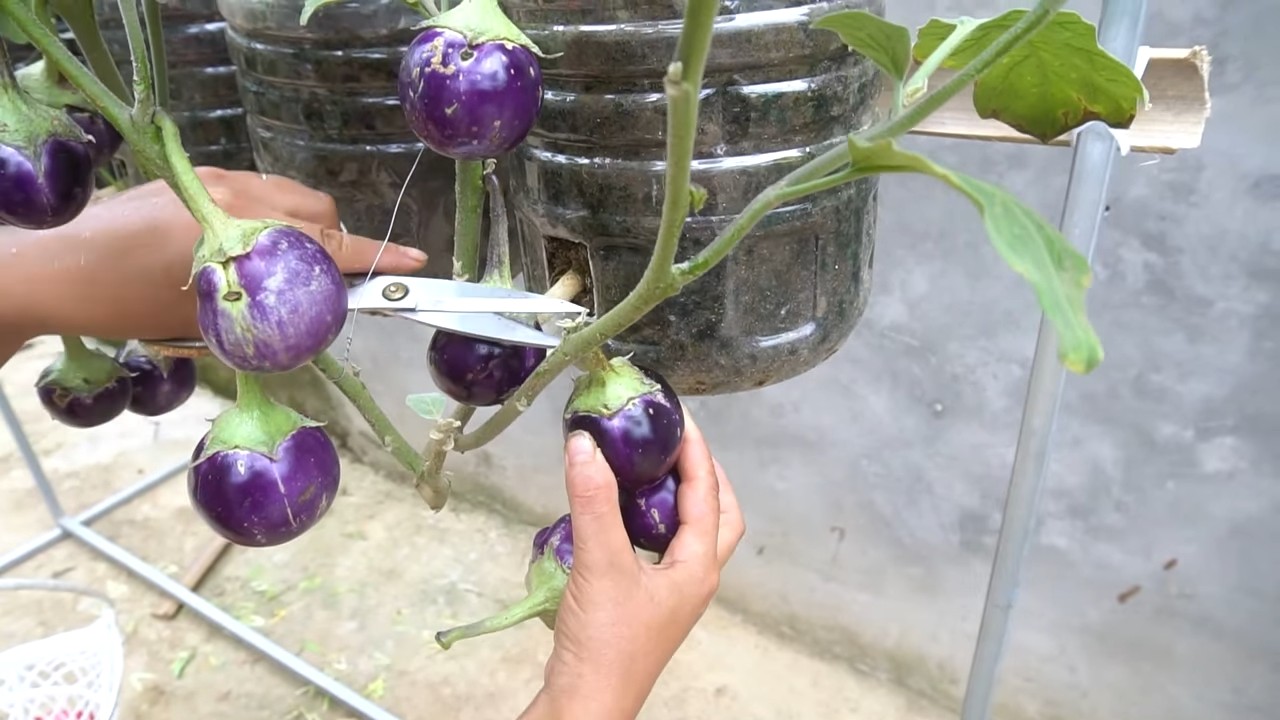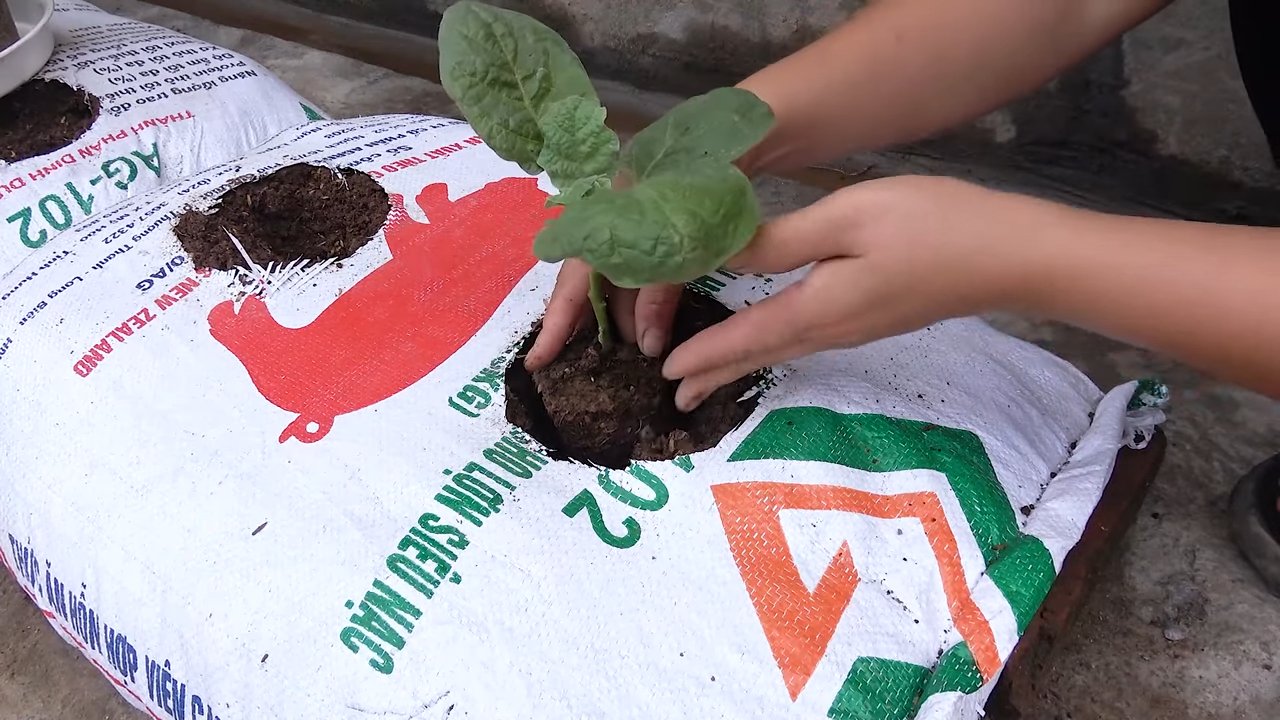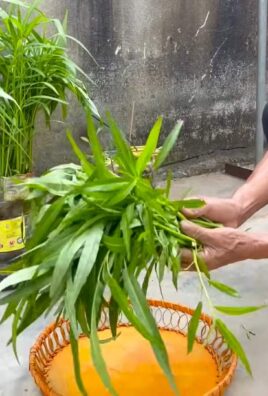Easy Eggplant Growing Setup: Dreaming of plump, glossy eggplants fresh from your own garden? I know I am! But the thought of complicated setups and finicky plants can be daunting. Fear not, fellow gardening enthusiasts! This article is your ultimate guide to creating an easy eggplant growing setup that even beginners can master.
Eggplants, also known as aubergines, have a rich history, originating in India and making their way across the globe. They’ve been cultivated for centuries, gracing tables with their unique flavor and versatility. But let’s be honest, sometimes they can be a bit temperamental. That’s where our DIY tricks come in!
Why do you need this? Well, store-bought eggplants often lack the vibrant flavor and freshness of homegrown ones. Plus, knowing exactly what goes into growing your food is incredibly rewarding. This DIY guide will walk you through creating a simple, effective setup that minimizes common eggplant growing problems, like pests and diseases, and maximizes your yield. I’ll share my favorite tips and tricks for building a thriving eggplant patch, from choosing the right container to providing the perfect support system. Get ready to harvest delicious, homegrown eggplants with minimal effort!

DIY: Building the Ultimate Eggplant Growing Setup (Even if You Have Limited Space!)
Hey there, fellow gardening enthusiasts! I’m so excited to share my tried-and-true method for growing plump, juicy eggplants, even if you’re short on space or just starting out. This DIY setup is all about maximizing yield and minimizing hassle. Get ready to impress your friends and family with your homegrown eggplant bounty!
What Makes This Setup So Great?
This isn’t just about sticking an eggplant seedling in the ground and hoping for the best. This setup focuses on:
* Optimized Drainage: Eggplants hate soggy feet! Proper drainage is crucial to prevent root rot and ensure healthy growth.
* Nutrient-Rich Soil: Eggplants are heavy feeders. We’ll create a soil mix that provides them with all the essential nutrients they need to thrive.
* Vertical Support: As eggplants grow, they can become quite heavy and prone to snapping. A sturdy support system is essential.
* Pest Protection: We’ll incorporate some simple strategies to deter common eggplant pests.
* Space Efficiency: Perfect for balconies, patios, or small gardens.
Materials You’ll Need
Before we dive in, let’s gather our supplies. Don’t worry, most of these are readily available at your local garden center or hardware store.
* Large Container (at least 15 gallons): A plastic pot, a repurposed barrel, or even a grow bag will work. Make sure it has drainage holes!
* Potting Mix: A high-quality potting mix specifically formulated for vegetables is ideal.
* Compost: This is the secret ingredient for nutrient-rich soil.
* Perlite or Vermiculite: These improve drainage and aeration.
* Slow-Release Fertilizer: Provides a steady supply of nutrients throughout the growing season. Look for one formulated for tomatoes or vegetables.
* Tomato Cage or Stakes: For supporting the eggplant as it grows. Tomato cages are super convenient.
* Twine or Plant Ties: To secure the eggplant to the support structure.
* Eggplant Seedling: Choose a variety that’s well-suited to your climate. I personally love ‘Black Beauty’ for its classic flavor and reliable production.
* Diatomaceous Earth (optional): A natural pest control option.
* Row Cover (optional): To protect young seedlings from pests and harsh weather.
* Gardening Gloves: To keep your hands clean!
* Trowel or Shovel: For mixing and planting.
Step-by-Step Instructions: Building Your Eggplant Paradise
Alright, let’s get our hands dirty! Follow these steps to create the perfect growing environment for your eggplant.
1. Preparing the Container
This is the foundation of our whole operation.
1. Ensure Drainage: If your container doesn’t have drainage holes, drill some! Eggplants absolutely need good drainage. Aim for at least four holes, each about half an inch in diameter.
2. Add a Layer of Gravel (Optional): Some people like to add a layer of gravel or pebbles at the bottom of the container to further improve drainage. I find it’s not always necessary with a good potting mix, but it can’t hurt. Just make sure it doesn’t block the drainage holes.
3. Line with Landscape Fabric (Optional): If you’re using a container with very large drainage holes, you might want to line the bottom with landscape fabric to prevent the soil from washing out.
2. Mixing the Perfect Soil
This is where the magic happens! A well-balanced soil mix is key to healthy eggplant growth.
1. Combine Potting Mix, Compost, and Perlite/Vermiculite: In a large container or wheelbarrow, mix together the potting mix, compost, and perlite/vermiculite. A good ratio is roughly 50% potting mix, 30% compost, and 20% perlite/vermiculite.
2. Incorporate Slow-Release Fertilizer: Follow the instructions on the fertilizer package to determine the correct amount to add to your soil mix. Mix it in thoroughly.
3. Moisten the Soil: Add water to the soil mix until it’s evenly moist, but not soggy. You should be able to squeeze a handful of soil and have it hold its shape without dripping water.
3. Planting Your Eggplant Seedling
Time to give your eggplant a new home!
1. Fill the Container: Fill the container with the prepared soil mix, leaving a few inches of space at the top.
2. Dig a Hole: Dig a hole in the center of the container that’s large enough to accommodate the eggplant seedling’s root ball.
3. Gently Remove the Seedling: Carefully remove the eggplant seedling from its nursery pot. Gently loosen the roots if they’re tightly packed.
4. Plant the Seedling: Place the seedling in the hole, making sure the top of the root ball is level with the surrounding soil.
5. Backfill with Soil: Fill in the hole with soil, gently firming it around the base of the plant.
6. Water Thoroughly: Water the newly planted eggplant thoroughly, until water drains out of the bottom of the container.
4. Setting Up Support
Eggplants can get heavy, so support is crucial!
1. Position the Tomato Cage or Stakes: Place the tomato cage around the eggplant seedling, or insert the stakes into the soil a few inches away from the plant.
2. Secure the Plant (As Needed): As the eggplant grows, use twine or plant ties to gently secure the stems to the support structure. This will prevent them from snapping under the weight of the fruit.
5. Pest Control (Optional)
Let’s keep those pesky critters away!
1. Apply Diatomaceous Earth: Sprinkle diatomaceous earth around the base of the plant to deter slugs, snails, and other crawling insects. Reapply after rain.
2. Use Row Cover: If you’re having trouble with flea beetles or other pests, cover the young seedlings with row cover. Remove the row cover once the plant starts to flower to allow for pollination.
Ongoing Care: Keeping Your Eggplant Happy and Healthy
Now that your eggplant is planted, it’s time to provide it with the care it needs to thrive.
1. Watering
Eggplants need consistent moisture, especially during hot weather.
* Water Deeply: Water deeply whenever the top inch of soil feels dry to the touch.
* Avoid Overwatering: Don’t let the soil become waterlogged, as this can lead to root rot.
* Water in the Morning: Water in the morning to allow the foliage to dry before nightfall, which can help prevent fungal diseases.
2. Fertilizing
Eggplants are heavy feeders and need regular fertilization to produce abundant fruit.
* Side-Dress with Compost: Every few weeks, side-dress the eggplant with a layer of compost.
* Liquid Fertilizer: Supplement with a liquid fertilizer formulated for tomatoes or vegetables every 2-3 weeks. Follow the instructions on the fertilizer package.
3. Pruning
Pruning can help improve air circulation and encourage fruit production.
* Remove Suckers: Remove any suckers (small shoots that grow from the base of the plant) to encourage the plant to focus its energy on fruit production.
* Remove Yellowing Leaves: Remove any yellowing or diseased leaves to prevent the spread of disease.
4. Pest and Disease Monitoring
Keep an eye out for pests and diseases and take action promptly.
* Inspect Regularly: Regularly inspect the eggplant for signs of pests or diseases, such as holes in the leaves, discoloration, or wilting.
* Treat Problems Promptly: If you spot any problems, take action promptly to prevent them from spreading. Use organic pest control methods whenever possible.
5. Harvesting
The most rewarding part!
* Harvest When Glossy and Firm: Harvest eggplants when they’re glossy, firm, and have reached the desired size.
* Use a Sharp Knife or Pruners: Use a sharp knife or pruners to cut the eggplant from the plant, leaving a short stem attached.
* Harvest Regularly: Harvest eggplants regularly to encourage the plant to produce more fruit.
Troubleshooting: Common Eggplant Problems and Solutions
Even with the best setup, you might encounter some challenges along the way. Here are some common eggplant problems and how to solve them:
* Blossom End Rot: This is caused by a calcium deficiency. Ensure consistent watering and consider adding calcium to the soil.
* Flea Beetles: These tiny pests can chew holes in the leaves. Use row cover or diatomaceous earth to control them.
* Aphids: These sap-sucking insects can

Conclusion
So, there you have it! Creating your own easy eggplant growing setup isn’t just a cost-effective alternative to expensive store-bought solutions; it’s a rewarding experience that connects you more deeply with the food you eat. We’ve walked you through the simple steps, highlighting the benefits of controlling your eggplant’s environment and ensuring optimal growth. From selecting the right container to crafting the perfect soil mix, every detail contributes to a healthier, more bountiful harvest.
But why is this DIY approach a must-try? Beyond the financial savings, it’s about empowerment. You gain complete control over the growing process, eliminating the guesswork and potential pitfalls associated with pre-packaged systems. You can tailor the setup to your specific climate, space constraints, and even aesthetic preferences. Imagine the satisfaction of nurturing your eggplant from seedling to fruit, knowing that you played a crucial role in its success.
And the possibilities don’t end here! Feel free to experiment with variations on our suggested setup. If you live in a particularly hot climate, consider adding shade cloth to protect your eggplant from scorching sun. For those with limited space, vertical gardening techniques can be easily incorporated into your DIY setup. You could even explore companion planting, adding herbs like basil or marigolds to deter pests and enhance the flavor of your eggplant.
Consider using recycled materials to build your setup. Old tires, plastic containers, or even wooden pallets can be repurposed into creative and functional planters. This not only reduces waste but also adds a unique, personal touch to your garden.
Another variation is to automate the watering system. A simple drip irrigation setup, connected to a timer, can ensure consistent moisture levels, especially during hot summer months. This is particularly useful if you travel frequently or have a busy schedule.
The key takeaway is that this DIY eggplant growing setup is a starting point, a foundation upon which you can build your own personalized gardening experience. Don’t be afraid to get creative, experiment with different techniques, and adapt the setup to your specific needs and preferences.
We are confident that by following these guidelines, you’ll be well on your way to enjoying a delicious and abundant eggplant harvest. Remember, the journey of growing your own food is just as rewarding as the final product. So, embrace the challenge, get your hands dirty, and experience the joy of nurturing your own eggplant from seed to table.
Now, we want to hear from you! Have you tried creating your own eggplant growing setup? What challenges did you face, and what successes did you achieve? Share your experiences, tips, and photos in the comments below. Let’s build a community of passionate gardeners, learning from each other and celebrating the joys of homegrown eggplant. Your insights could inspire others to embark on their own gardening adventures. Let’s cultivate a thriving community of eggplant enthusiasts!
FAQ
What are the benefits of using a DIY eggplant growing setup compared to buying one?
The primary benefits of a DIY eggplant growing setup are cost savings, customization, and control. Store-bought setups can be expensive, and they may not be perfectly suited to your specific climate or space. With a DIY setup, you can tailor the materials and design to your needs, using recycled or readily available resources. You also have complete control over the soil composition, watering schedule, and pest control methods, ensuring that your eggplant receives the optimal care. Furthermore, building your own setup is a rewarding experience that connects you more deeply with the food you grow.
What type of container is best for growing eggplant in a DIY setup?
Eggplants need plenty of room for their roots to grow, so choose a container that is at least 12-14 inches in diameter and depth. Good options include large plastic pots, wooden crates, or even repurposed containers like old tires or buckets. Ensure that the container has adequate drainage holes to prevent waterlogging, which can lead to root rot. The material of the container isn’t as important as its size and drainage capabilities.
What kind of soil mix should I use for my DIY eggplant growing setup?
Eggplants thrive in well-draining, nutrient-rich soil. A good soil mix consists of equal parts compost, peat moss (or coconut coir), and perlite (or vermiculite). Compost provides essential nutrients, peat moss (or coconut coir) helps retain moisture, and perlite (or vermiculite) improves drainage. You can also add a slow-release fertilizer to the mix to provide a steady supply of nutrients throughout the growing season. Avoid using garden soil, as it can be too heavy and may contain pests or diseases.
How often should I water my eggplant in a DIY growing setup?
Water your eggplant regularly, especially during hot, dry weather. The soil should be consistently moist but not waterlogged. Check the soil moisture by sticking your finger about an inch into the soil. If it feels dry, it’s time to water. Water deeply, allowing the water to drain out of the bottom of the container. Avoid watering the foliage, as this can promote fungal diseases. A good rule of thumb is to water every 2-3 days, but adjust the frequency based on the weather and the plant’s needs.
How much sunlight does eggplant need in a DIY growing setup?
Eggplant requires at least 6-8 hours of direct sunlight per day to thrive. Choose a location for your DIY setup that receives plenty of sunlight throughout the day. If you live in a particularly hot climate, you may need to provide some afternoon shade to prevent the plants from overheating. If you don’t have access to enough natural sunlight, you can supplement with grow lights.
How can I protect my eggplant from pests and diseases in a DIY growing setup?
Regularly inspect your eggplant for signs of pests or diseases. Common pests include aphids, flea beetles, and spider mites. You can control these pests with insecticidal soap, neem oil, or by handpicking them off the plants. To prevent fungal diseases, ensure good air circulation around the plants and avoid overhead watering. You can also use a fungicide if necessary. Companion planting with herbs like basil or marigolds can also help deter pests.
Can I grow eggplant in a DIY setup indoors?
Yes, you can grow eggplant indoors, but it requires careful attention to lighting and temperature. You’ll need to provide at least 12-14 hours of light per day using grow lights. The ideal temperature range for eggplant is 70-85°F during the day and 60-70°F at night. You’ll also need to pollinate the flowers by hand, as there won’t be any bees or other pollinators indoors.
What are some common problems I might encounter when growing eggplant in a DIY setup, and how can I fix them?
Some common problems include blossom drop (flowers falling off without producing fruit), stunted growth, and pest infestations. Blossom drop can be caused by temperature stress, lack of pollination, or nutrient deficiencies. Stunted growth can be caused by poor soil, lack of sunlight, or pest infestations. Address these problems by providing optimal growing conditions, ensuring adequate pollination, and controlling pests.
How long does it take to grow eggplant from seed to harvest in a DIY setup?
It typically takes 70-90 days to grow eggplant from seed to harvest. You can start seeds indoors 6-8 weeks before the last expected frost. Transplant the seedlings into your DIY setup after the danger of frost has passed. Be patient, and remember that the exact time to harvest will depend on the variety of eggplant you are growing.
What are some different varieties of eggplant that I can grow in my DIY setup?
There are many different varieties of eggplant to choose from, each with its own unique characteristics. Some popular varieties include Black Beauty, Ichiban, and Rosa Bianca. Black Beauty is a classic variety with large, dark purple fruits. Ichiban is a Japanese variety with long, slender fruits. Rosa Bianca is an Italian variety with round, lavender-colored fruits. Choose a variety that is well-suited to your climate and growing conditions.




Leave a Comment